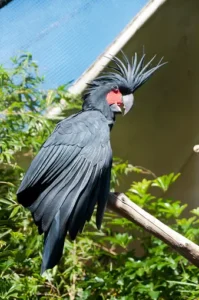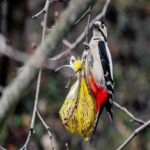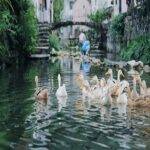The Black Palm Cockatoo, regarded as the largest among the cockatoo family, this striking bird is known for its jet-black plumage and impressive crest that adds to its majestic appearance.
Measuring up to 70 centimeters (27.5 inches) in length, the Black Palm Cockatoo is easily distinguished by its unique facial features, which include a large black beak and bright red patches around its eyes.

Vocalization:
These distinctive traits give the bird an intense and captivating gaze. One of the most remarkable aspects of this species is its impressive vocal ability.
The Black Palm Cockatoo is highly vocal, emitting a range of calls and whistles that echo through the dense rainforest canopy. These vocalizations are crucial for communication and mate attraction within their social groups.
Origin and evolution of Black Palm Cockatoo:
The origin of the Black Palm Cockatoo can be traced back to the ancient landmass of Gondwana, a supercontinent that existed around 180 million years ago. Gondwana included present-day South America, Africa, India, Australia, Antarctica, and New Guinea. As the continents gradually drifted apart, Australia and New Guinea formed a single landmass known as Sahul approximately 60 million years ago.
During this time, various species of cockatoos, including the ancestors of the Black Palm Cockatoo, likely migrated to the region. As Australia and New Guinea continued to drift apart, they became isolated from each other and from the rest of the world.
This isolation led to the development of unique and diverse ecosystems, allowing different species of flora and fauna, including birds, to evolve in distinct ways. Over time, the Black Palm Cockatoo’s ancestors adapted to the lush rainforest environments of New Guinea, evolving specific traits and behaviors that suited their surroundings.
Behavior:

Black Palm Cockatoos are highly vocal birds and have a wide repertoire of calls, squawks, whistles, and screeches. They use vocalizations for communication with their flock members, especially during feeding and social interactions. Their loud and resonating calls can carry over long distances in the dense rainforest canopy.
One of the striking behaviors of Black Palm Cockatoos is their crest display. When excited or agitated, they can raise their impressive crest, adding to their majestic appearance. This display is also used during courtship to attract potential mates.
These cockatoos are social birds and often form small flocks or family groups. Within these groups, they engage in various social interactions, such as grooming each other and playing.
While Black Palm Cockatoos are not as renowned for their mimicry abilities as some other parrot species, they can still learn to imitate certain sounds and vocalizations from their environment and human caretakers.
Must Visit: How Rabies Virus effect Pets and Human
Are They Flock Breeders?
No, Black Palm Cockatoos (Probosciger aterrimus) are not typically considered flock breeders. They are known to be more solitary or form small family groups during the breeding season.
Unlike some other parrot species that may breed in large colonies or flocks, Black Palm Cockatoos prefer to establish monogamous pair bonds. They form long-term relationships with their chosen mate and raise their chicks together.
During the breeding season, a mated pair of Black Palm Cockatoos will search for a suitable nesting site, often a tree hollow, where the female will lay one or two eggs. Both parents take an active role in incubating the eggs and caring for the chicks once they hatch.
While they may socialize with other individuals outside of the breeding season, especially during feeding or while roosting, they are not as known for forming large flocks for breeding purposes.

Breeding Season of Black Palm Cockatoos:
The breeding season of Black Palm Cockatoos (Probosciger aterrimus) can vary depending on their location within their native range, which includes the rainforests of New Guinea and nearby islands.
In general, the breeding season for Black Palm Cockatoos tends to align with the wet season or the period of increased rainfall and food availability. This is usually a time when there is a greater abundance of fruits, seeds, and other food resources, providing the necessary nutrition for successful breeding and raising of chicks.
In parts of their range, the breeding season typically occurs from around August to December. During this time, mated pairs engage in courtship displays, which may involve vocalizations, crest-raising, and other behaviors to strengthen their bond. They will then search for a suitable nesting site, usually a tree hollow, where the female lays one or two eggs. The incubation period lasts around 30 days, and both parents take turns incubating the eggs and caring for the chicks once they hatch.
Health Tips of Black Palm Cockatoo:
- Balanced Diet: Ensure your Black Palm Cockatoo receives a balanced diet of high-quality pellets, fresh fruits, vegetables, and occasional nuts. This diverse diet provides essential nutrients for their overall health.
- Regular Exercise: Encourage physical activity by providing toys, perches of different sizes, and opportunities for flight within a safe environment to maintain their physical and mental well-being.
- Mental Stimulation: Offer puzzles, foraging toys, and interactive playtime to keep their highly intelligent minds engaged and prevent boredom.
- Regular Veterinary Check-ups: Schedule regular visits to an avian veterinarian for health assessments, vaccinations (if necessary), and to address any potential health issues early on.
- Hygiene and Cleanliness: Maintain a clean living space, including food and water dishes, to prevent the spread of bacteria and ensure the bird’s surroundings are hygienic and safe.
Visit For More Info: Amazing Top 15 birds with long beaks
Identifying Illness, Aggression or Societal Disharmony:

Identifying illness, aggression, or societal disharmony in Black Palm Cockatoos requires careful observation of their behavior, appearance, and interactions.
- Illness: Look for signs of lethargy, reduced appetite, abnormal droppings, fluffed-up feathers, sneezing, or discharge from the eyes or nostrils. Changes in vocalization, difficulty breathing, or any sudden behavioral shifts may also indicate illness. If you notice any concerning symptoms, consult an avian veterinarian immediately.
- Aggression: Aggression in Black Palm Cockatoos can manifest as biting, lunging, screaming, or territorial behavior. Aggressive birds may also puff up their feathers and show signs of fear or stress. Identifying triggers for aggression and seeking the help of an experienced avian behaviorist can aid in resolving the issue.
- Societal Disharmony: Social disharmony among Black Palm Cockatoos may be observed as increased squabbling, excessive vocalizations, or attempts to avoid or isolate from other birds. Watch for any signs of tension or bullying within a group of birds. Providing enough space, separate feeding areas, and attention to individual needs can help maintain harmony in multi-bird households.
Must Visit: Why Grooming is essential for Pets
Major Diseases and Treatments:
- Psittacine Beak and Feather Disease (PBFD): A viral disease affecting feathers and beak. No cure, but supportive care, quarantine, and good hygiene are essential to prevent its spread.
- Avian Bornavirus (ABV): A viral infection causing neurologic signs. No cure, supportive care, and antiviral therapy may be used to manage symptoms.
- Fungal : A fungal respiratory infection. Treatment involves antifungal medications and improving the bird’s living conditions to reduce exposure to the fungus.
- Bacterial Infections: Various bacterial infections can affect Black Palm Cockatoos. Treatment includes antibiotics prescribed by an avian veterinarian based on culture and sensitivity testing.
- Feather Picking: While not a disease, feather picking can be a behavioral problem. Identifying and addressing the underlying cause, such as stress or boredom, is essential. Environmental enrichment and behavioral modification can help manage feather picking behavior.
Always consult with an experienced avian veterinarian for proper diagnosis and treatment of any health issues in Black Palm Cockatoos. Regular check-ups and a proactive approach to their care can help prevent and manage potential diseases effectively.
Colors And Markings:

The Black Palm Cockatoo (Probosciger aterrimus) overall plumage is predominantly black, which gives it a bold and majestic appearance. Here are some specific colors and markings of the Black Palm Cockatoo:
- Black Plumage: The entire body of the Black Palm Cockatoo, including the head, neck, wings, and tail, is covered in black feathers. This jet-black coloration is one of the primary features that set this species apart from other cockatoos.
- Red Facial Patches: Around each eye, the Black Palm Cockatoo has a bright red patch of bare skin known as the orbital skin. These patches add a splash of color to their otherwise dark appearance and become more prominent when they are excited or during courtship displays.
- Black Crest: The Black Palm Cockatoo has a distinctive crest on its head, which it can raise and lower depending on its mood. The crest feathers are also black, blending with the rest of its plumage when not raised.
- Grey Feet and Legs: The feet and legs of the Black Palm Cockatoo are a pale grey color, providing a subtle contrast to its black plumage.
These colors and markings give the Black Palm Cockatoo a visually stunning and unique appearance, making it one of the most sought-after species among bird enthusiasts and aviculturists. It’s essential to appreciate these magnificent birds in their natural habitat and support conservation efforts to protect them from the threats they face in the wild.
Must Visit: 6 Amazing Types of German Shepherd Dogs
Size of Black Palm Cockatoo:

The Black Palm Cockatoo (Probosciger aterrimus) is the largest of all cockatoo species. Adult Black Palm Cockatoos can measure up to 60 to 70 centimeters (approximately 24 to 27.5 inches) in length from the top of their head to the tip of their tail. This impressive size, coupled with their jet-black plumage and bright red facial patches, makes them one of the most iconic and striking parrots in the world.
Habitat And Climate:

The Black Palm Cockatoo (Probosciger aterrimus) is native to the rainforests of New Guinea and nearby islands, including Misool and Yamen. These rainforests are part of the Australasian ecozone, characterized by rich biodiversity and lush vegetation.
Habitat:
Black Palm Cockatoos inhabit lowland and hill rainforests, particularly those with a dense canopy, large trees, and abundant fruiting trees. They are also known to occur in secondary growth forests, provided there is suitable nesting and feeding opportunities. The presence of large, old-growth trees with natural tree hollows is crucial for their breeding and nesting needs.
Climate:
The climate in the native range of the Black Palm Cockatoo is tropical, characterized by warm temperatures and high humidity. The region experiences distinct wet and dry seasons. The wet season, often occurring from November to April, brings heavy rainfall and increased fruit availability, which is essential for their feeding and breeding activities. The dry season, from May to October, sees reduced rainfall and can lead to changes in food availability, which can impact their foraging behavior.
Must Visit: 8 General effects of calicivirus
Pet Care Tips:

Caring for a Black Palm Cockatoo (Probosciger aterrimus) requires dedication, knowledge, and a commitment to meeting their specific needs. Here are some essential care tips for these magnificent birds:
- Spacious Enclosure: Provide a large and spacious aviary or cage, as Black Palm Cockatoos are among the largest cockatoo species. They need ample room to move, climb, and exercise their wings.
- Mental Stimulation: These intelligent birds thrive on mental stimulation. Offer a variety of toys, puzzles, and enrichment activities to keep them engaged and prevent boredom.
- Balanced Diet: Offer a diverse and balanced diet consisting of high-quality pellets, fresh fruits, vegetables, nuts, and occasional treats. Avoid feeding them harmful foods like chocolate, caffeine, and avocados.
- Social Interaction: Black Palm Cockatoos are social birds and require regular interaction with their human caretakers. Spend time playing and bonding with your bird daily to foster a strong relationship.
- Grooming: Regularly trim their flight feathers and nails to ensure they are safe and prevent injury. Allow them to bathe regularly, either with a water dish or by misting them gently.
- Environmental Enrichment: Mimic their natural habitat by providing sturdy perches of different sizes and textures. Add natural branches for climbing and gnawing, as well as foraging toys to encourage mental stimulation.
- Vet Check-ups: Schedule regular check-ups with an avian veterinarian to monitor their health and catch any potential health issues early.
- Noise Control: Be mindful of their loud vocalizations and potential noise disturbances. Provide a calm and quiet environment when needed.
- Positive Reinforcement Training: Use positive reinforcement methods to train and interact with your Black Palm Cockatoo. Reward good behavior and avoid punishment-based training.
- Secure Environment: Ensure their living area is safe, free of toxic substances, and protected from potential hazards.
Caring for Black Palm Cockatoos requires a long-term commitment and a deep understanding of their needs. By providing proper care, attention, and love, you can build a strong and fulfilling bond with these majestic birds.
Must Visit: 12 Important Effects of Skin Fungal Infection In Cats
Black Palm Cockatoo Favorite Food:
The Black Palm Cockatoo (Probosciger aterrimus) is a magnificent and striking parrot species native to the rainforests of northern Australia and Papua New Guinea. These birds have unique dietary preferences that reflect their natural habitat and behaviors.
One of their favorite foods is the seeds of various rainforest trees, especially the Podocarpus and Pandanus species. These large and powerful birds use their powerful beaks to crack open the tough outer shells of these seeds, revealing the nutrient-rich inner kernels. Their strong jaws and beaks are perfectly adapted for this task.
In addition to seeds, Black Palm Cockatoos also enjoy a variety of fruits, including wild figs, papaya, and various types of berries. They are known to forage for these fruits in the rainforest canopy, using their agile and acrobatic flying skills to navigate through the dense vegetation.
These cockatoos are also opportunistic feeders, and they may consume insects, grubs, and larvae when they come across them while foraging. This behavior provides them with an additional source of protein in their diet.
Furthermore, Black Palm Cockatoos have been observed feeding on the inner bark of certain trees, which can provide them with essential nutrients and fibers.
In captivity, it is essential to replicate their natural diet to ensure their health and well-being. A balanced diet for pet Black Palm Cockatoos typically consists of a mix of fresh fruits, nuts, vegetables, and specially formulated parrot pellets.
Understanding and catering to the Black Palm Cockatoo’s favorite foods is essential for their survival in the wild and their overall health in captivity. These majestic birds are a vital part of their ecosystem and a treasure for bird enthusiasts around the world.
FAQ’s:
What makes the Black Palm Cockatoo unique among other cockatoo species?
The Black Palm Cockatoo stands out due to its large size, striking jet-black plumage, and vibrant red facial patches around its eyes.
Q: What is the natural habitat of Black Palm Cockatoos?
Black Palm Cockatoos are native to the rainforests of New Guinea and nearby islands, where they thrive in dense, lush vegetation.
Q: Are Black Palm Cockatoos good talkers like some other parrot species?
While they can mimic some sounds, Black Palm Cockatoos are not known for extensive talking abilities. They are more renowned for their impressive vocalizations and calls.
Q: What should I feed my Black Palm Cockatoo for a balanced diet?
A well-balanced diet for Black Palm Cockatoos includes high-quality pellets, fresh fruits, vegetables, nuts, and occasional treats. Avoid feeding harmful foods like chocolate and caffeine.
Q: How do Black Palm Cockatoos behave in captivity?
In captivity, Black Palm Cockatoos need mental stimulation, social interaction, and plenty of space to move and exercise. They are intelligent and social birds that require daily interaction and enrichment activities to thrive.
Must Visit: Essential Info About Parvo Virus



I have learned newer and more effective things via your web site. One other thing I’d prefer to say is always that newer laptop os’s are inclined to allow far more memory to be played with, but they also demand more storage simply to run. If your computer cannot handle a lot more memory along with the newest software package requires that ram increase, it may be the time to buy a new Computer. Thanks